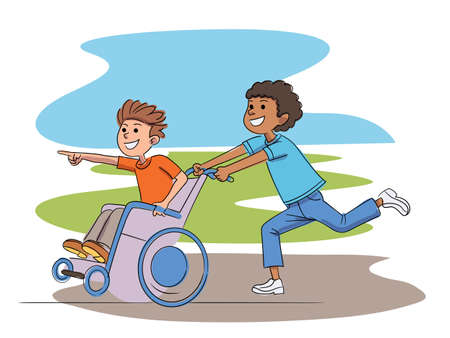Introduction to Nature-Based Therapy
Nature-based therapeutic activities have gained significant traction in recent years as innovative approaches for supporting children’s mental health and rehabilitation. Rooted in the principles of ecotherapy, these interventions leverage the restorative qualities of natural environments—such as parks, woodlands, and gardens—to promote psychological and physical wellbeing. In the UK, where urban green spaces and expansive countryside are integral to local culture, there has been a marked increase in initiatives that utilise the outdoors for therapeutic purposes. This trend is underpinned by a growing body of research demonstrating that interaction with nature can reduce anxiety, improve mood, enhance social skills, and foster resilience in young people. British parks, with their accessibility and rich biodiversity, are emerging as preferred settings for such programmes. As awareness around childhood wellbeing grows and traditional clinical settings face mounting pressures, nature-based therapy offers an evidence-based complement that resonates deeply with both practitioners and families across the country.
British Parks as Healing Spaces
British parks have long held a special place in the nation’s heart, serving not only as recreational hubs but also as vital green spaces for restoration and wellbeing. Their unique features and traditions make them especially suitable for nature-based therapeutic activities aimed at children’s rehabilitation. The following exploration highlights the accessibility, cultural significance, and suitability of British parks for such purposes.
Accessibility: Open Gates to All
A defining characteristic of British parks is their commitment to public accessibility. Most urban and suburban communities feature local parks that are free to enter, often designed with pathways suitable for wheelchairs and prams, making them inclusive for children with varying mobility needs. Additionally, many parks have sensory gardens, accessible toilets, and clear signposting in both English and other community languages, reducing barriers for diverse populations.
| Park Feature | Description | Benefit for Rehabilitation |
|---|---|---|
| Open Lawns | Large grassy areas for play and relaxation | Encourages movement and social interaction |
| Sensory Gardens | Spaces with varied textures, scents, and colours | Stimulation for cognitive and sensory development |
| Paved Pathways | Smooth walkways throughout the park | Inclusive access for children with mobility aids |
| Community Playgrounds | Equipment suitable for all ages and abilities | Supports physical rehabilitation through play |
| Ponds & Woodlands | Diverse natural habitats within park grounds | Facilitates environmental learning and mindfulness |
Cultural Significance: More than Green Spaces
Parks in Britain are woven into the fabric of daily life, often hosting community events such as fêtes, open-air theatre, or guided nature walks. This tradition cultivates a sense of belonging and collective responsibility for shared spaces. For children undergoing rehabilitation, engaging in group activities within these environments fosters social skills and emotional resilience—qualities highly valued in British society.
Historical Roots and Modern Adaptations
The concept of public parks has its roots in Victorian England, emphasising moral improvement through access to nature. Over time, these spaces have evolved to accommodate modern needs while retaining their role as places of respite. Today’s parks often integrate therapeutic horticulture projects, ‘forest school’ sessions, and wildlife conservation programmes—all aligning with contemporary understandings of holistic child development.
Suitability for Childrens Rehabilitation Programmes
The carefully curated mix of formal gardens, wild meadows, water features, and interactive installations makes British parks uniquely adaptable settings for structured outdoor rehabilitation programmes. Children can participate in both individual and group-based therapeutic activities under professional supervision, benefiting from the calming influence of nature combined with purposeful engagement.

3. Core Nature-Based Activities for Children
Forest Schools: Immersive Learning in Woodlands
Forest schools have become an increasingly popular model across the United Kingdom, offering children structured opportunities to engage with nature in local woodlands and parks. These programmes emphasise experiential learning, problem-solving, and teamwork in outdoor settings, reflecting the British appreciation for ‘learning by doing’. Under the guidance of trained practitioners, children participate in activities such as den-building, fire-lighting (with strict safety protocols), and bushcraft skills. The woodland environment not only encourages physical activity but also nurtures resilience, self-confidence, and a sense of stewardship for British natural landscapes.
Wildlife Observation: Fostering Curiosity and Connection
British parks are rich habitats for native species, making wildlife observation a foundational element of outdoor rehabilitation. Activities might include bird-watching with binoculars, identifying insects and small mammals, or participating in seasonal nature walks led by local experts. These experiences cultivate curiosity about biodiversity and encourage children to develop mindfulness through quiet observation. In line with British environmental education standards, such interventions often link to national curricula themes like conservation and sustainability, reinforcing the significance of local flora and fauna.
Gardening: Cultivating Wellbeing Through Hands-On Engagement
Community gardens within public parks or school grounds offer an accessible platform for therapeutic gardening activities tailored to children’s abilities. Planting seeds, tending to vegetable patches, and harvesting produce help young participants develop practical skills while fostering patience and responsibility. British gardening traditions—such as growing native wildflowers or maintaining pollinator-friendly beds—are often incorporated to create a sense of continuity with local heritage. For children facing physical or emotional challenges, adapted tools and raised beds ensure inclusivity and engagement.
Sensory Play: Stimulating Development Through Natural Elements
Sensory play is particularly valuable for children with additional needs, providing multi-sensory stimulation through touch, sight, sound, and smell. British park environments offer abundant resources for this type of play: textured leaves, fragrant herbs from herbaceous borders, mud kitchens constructed from reclaimed materials, or water features designed for safe exploration. Sensory trails—marked routes that highlight different textures and sounds—are increasingly found in UK green spaces. Such initiatives support cognitive development and emotional regulation while celebrating the diversity of Britain’s natural environments.
Adaptation to Local Contexts
All these core activities are thoughtfully adapted to reflect local ecological characteristics, seasonal changes, and cultural traditions unique to Britain. Practitioners collaborate with families and local authorities to ensure activities are inclusive and responsive to community needs. By embedding nature-based therapeutic interventions within familiar park settings, children can build meaningful connections with their immediate environment—laying the groundwork for lifelong health and wellbeing.
4. Benefits for Child Development and Rehabilitation
Engaging children in nature-based therapeutic activities within British parks provides a multifaceted approach to development and rehabilitation. Evidence from UK-based studies highlights significant physical, psychological, and social benefits, making outdoor rehabilitation an essential component of paediatric care and educational support.
Physical Benefits
Outdoor activities such as nature walks, gardening, and sensory trails in parks foster gross and fine motor skill development. According to a study conducted by the University of Exeter (2022), children participating in structured nature play demonstrated improved balance, coordination, and muscular strength compared to peers in conventional indoor settings. Additionally, exposure to natural sunlight has been linked with increased Vitamin D synthesis, essential for bone health and immune function.
| Physical Benefit | Nature-Based Activity Example | UK Research Reference |
|---|---|---|
| Motor Skills Improvement | Obstacle courses using park equipment | Exeter Study (2022) |
| Enhanced Cardiovascular Health | Group hiking sessions | NHS Community Health Report (2021) |
| Vitamin D Uptake | Sunlight exposure during park play | British Medical Journal (BMJ, 2020) |
Psychological Benefits
The psychological advantages are equally compelling. Nature-based interventions have been shown to reduce symptoms of anxiety and depression in children. For instance, Mind UK’s “Green Spaces for Mental Health” initiative found that regular engagement with green spaces led to enhanced mood stability and reduced behavioural issues among children with learning disabilities. The restorative quality of natural environments can also aid in attention restoration, crucial for children diagnosed with ADHD or autism spectrum conditions.
Case Example: The London Wild Child Project
This project involved weekly outdoor therapy sessions in Hampstead Heath for children referred by local NHS trusts. Evaluations indicated a 30% reduction in reported anxiety symptoms over six months, as well as notable improvements in emotional regulation.
Social Benefits
Parks offer inclusive spaces where children from diverse backgrounds can interact through shared activities. Collaborative tasks such as team-building games or community gardening encourage communication skills, empathy, and conflict resolution. A 2021 report by Play England highlighted how structured group play in public parks led to stronger peer relationships and better integration of children with special educational needs into mainstream social groups.
| Social Skill Developed | Activity Type | UK-Based Outcome/Case Study |
|---|---|---|
| Teamwork & Cooperation | Group treasure hunts | Bristol Parks Trust Pilot (2021) |
| Conflict Resolution | Role-play scenarios outdoors | Liverpool City Council Green Play Study (2022) |
| Cultural Inclusion | Community gardening projects | Play England Report (2021) |
Synthesis of Evidence from the UK Context
The growing body of research underscores that nature-based rehabilitation is not merely recreational but constitutes a vital therapeutic intervention for holistic child development. British parks serve as accessible venues where multidisciplinary teams—therapists, educators, and parents—can collaborate to support children’s growth across physical, psychological, and social domains.
5. Role of Practitioners and Community Support
Effective nature-based therapeutic activities for children in British parks rely heavily on the collaborative involvement of a diverse range of professionals and community stakeholders. Occupational therapists play a pivotal role in the design and adaptation of outdoor rehabilitation programmes, ensuring that activities are tailored to meet individual needs and developmental goals. Their expertise facilitates the integration of sensory, motor, and social objectives into sessions, making outdoor interventions both therapeutic and engaging.
Educators also contribute significantly by embedding outdoor learning within the school curriculum and advocating for regular access to local green spaces. Many British schools now work closely with local councils to organise visits to public parks, recognising the value of experiential learning and the positive impact on children’s mental health and wellbeing. This partnership between educators and health professionals enhances consistency across therapeutic and educational settings, providing children with holistic support.
The Importance of Local Councils
Local councils in the UK serve as essential facilitators in this collaborative framework. By maintaining accessible, safe, and inclusive park environments, councils create opportunities for structured programmes led by therapists and teachers. They often provide logistical support, allocate funding for inclusive playground equipment, and promote initiatives such as ‘forest schools’ or seasonal outdoor events tailored to young people with additional needs.
Community Involvement
Community groups, including parent associations and volunteer organisations, further reinforce these efforts by raising awareness and encouraging active participation among families. Their advocacy ensures that local authorities prioritise child-friendly spaces and invest in resources necessary for long-term programme sustainability.
Conclusion: A Unified Approach
This multi-layered collaboration—uniting occupational therapists, educators, local councils, and community members—forms the backbone of successful nature-based therapeutic interventions in British parks. Through shared commitment and resource pooling, these stakeholders create supportive environments where children can thrive physically, emotionally, and socially amidst nature.
6. Challenges and Considerations in the UK Context
Weather as a Fundamental Barrier
The British climate, renowned for its unpredictability and frequent rainfall, presents a significant challenge to nature-based therapeutic activities for children. Outdoor rehabilitation programmes are often affected by sudden weather changes, ranging from heavy downpours to chilly winds. This can disrupt planned sessions, reduce participation rates, and limit the use of parks during certain seasons. To address this, practitioners have begun incorporating flexible schedules and providing suitable clothing and shelter options, ensuring that children can participate safely and comfortably regardless of the weather.
Accessibility of British Parks
While the UK boasts an extensive network of public parks, accessibility remains a concern for many families and children with disabilities. Physical barriers such as uneven paths, limited wheelchair access, and insufficient signage can restrict participation. Socioeconomic factors may also influence access, particularly in urban areas where green spaces are less evenly distributed. In response, local councils and charitable organisations are increasingly prioritising inclusive design in park renovations and promoting accessible transport links to encourage broader community engagement in outdoor therapeutic programmes.
Cultural Perceptions of Nature-Based Therapy
Another consideration within the British context is the cultural perception of nature-based interventions. While there is growing recognition of their benefits, some parents and professionals still view outdoor therapy as supplementary rather than essential. Additionally, concerns about safety, supervision, and the perceived value of unstructured play can act as deterrents. Educational campaigns and evidence-based advocacy are gradually shifting these attitudes by highlighting positive outcomes for childrens mental health and development.
Approaches to Addressing Barriers
Overcoming these challenges requires a multifaceted approach tailored to the UK setting. Collaboration between local authorities, healthcare providers, and educational institutions is crucial in fostering understanding and support for nature-based therapies. Training staff to adapt activities according to weather conditions, ensuring parks meet accessibility standards, and raising awareness through community outreach all contribute to more effective implementation. By acknowledging and proactively addressing these challenges, British parks can become truly inclusive spaces for therapeutic outdoor rehabilitation.
7. Future Directions and Recommendations
Strengthening Policy Frameworks
To maximise the benefits of nature-based therapeutic activities for children, it is vital to embed these initiatives within robust policy frameworks. Local authorities and national government bodies should work collaboratively to develop clear guidelines that prioritise outdoor rehabilitation in British parks. This may involve updating existing health, education, and environmental policies to formally recognise the value of nature-based therapies for child development and wellbeing.
Securing Sustainable Funding
A critical step in enhancing the impact of outdoor rehabilitation is ensuring consistent financial support. Allocating dedicated funds from both public and private sectors can help maintain park infrastructure, provide training for facilitators, and supply necessary resources for therapeutic programmes. Charitable grants, social enterprise models, and partnerships with local businesses could all play a role in securing long-term investment.
Fostering Community Engagement
Community involvement is essential for the success and sustainability of nature-based therapeutic activities. Initiatives that encourage families, schools, and local organisations to take part in programme planning and delivery foster a sense of ownership and relevance. Volunteer opportunities, educational workshops, and open days can further strengthen community ties while raising awareness about the benefits of outdoor rehabilitation.
Promoting Inclusivity and Accessibility
Efforts should also focus on making British parks more inclusive environments for all children, including those with disabilities or from underrepresented backgrounds. This could involve improving physical accessibility, developing culturally sensitive programming, and offering targeted outreach to ensure equitable participation.
Collaborative Research and Evaluation
Ongoing research is needed to refine best practices in nature-based therapy. Partnerships between universities, NHS trusts, councils, and third sector organisations can drive evidence-based innovation. Regular evaluation will help identify which approaches yield the most significant outcomes for children’s physical, emotional, and social rehabilitation.
Conclusion
The future of nature-based therapeutic activities in British parks depends on strategic coordination across policy, funding streams, community initiatives, inclusivity measures, and research efforts. By prioritising these recommendations, stakeholders can create a resilient framework that not only enhances childrens wellbeing but also strengthens the social fabric of communities across the UK.


